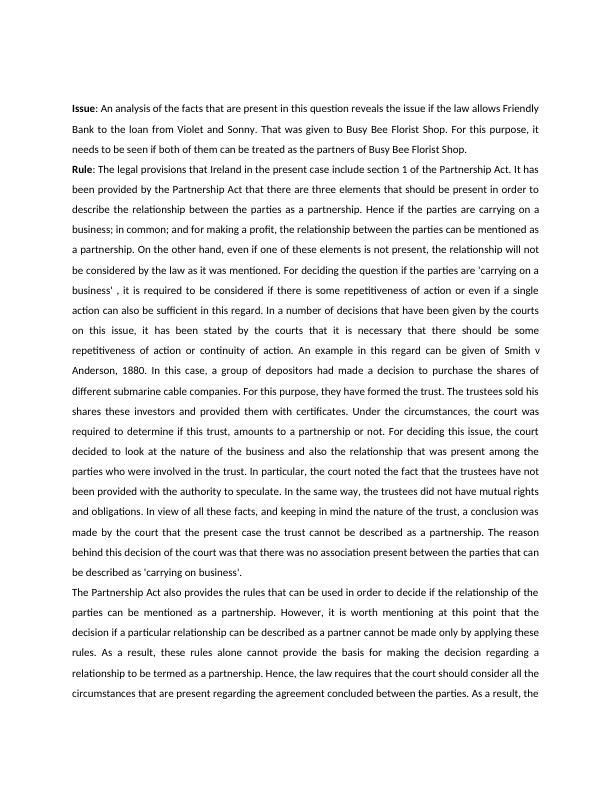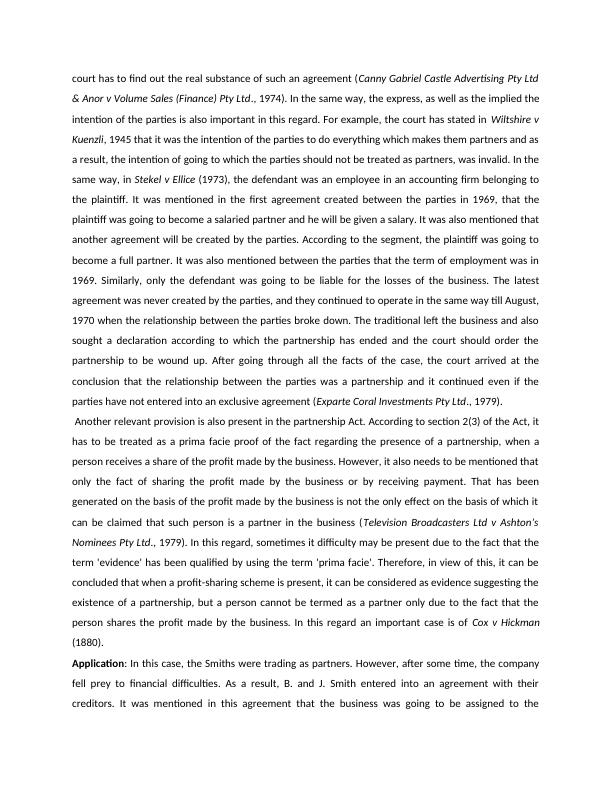Partnership Act Assignment
Added on 2020-03-15
5 Pages2088 Words43 Views
Issue: An analysis of the facts that are present in this question reveals the issue if the law allows FriendlyBank to the loan from Violet and Sonny. That was given to Busy Bee Florist Shop. For this purpose, itneeds to be seen if both of them can be treated as the partners of Busy Bee Florist Shop. Rule: The legal provisions that Ireland in the present case include section 1 of the Partnership Act. It hasbeen provided by the Partnership Act that there are three elements that should be present in order todescribe the relationship between the parties as a partnership. Hence if the parties are carrying on abusiness; in common; and for making a profit, the relationship between the parties can be mentioned asa partnership. On the other hand, even if one of these elements is not present, the relationship will notbe considered by the law as it was mentioned. For deciding the question if the parties are 'carrying on abusiness' , it is required to be considered if there is some repetitiveness of action or even if a singleaction can also be sufficient in this regard. In a number of decisions that have been given by the courtson this issue, it has been stated by the courts that it is necessary that there should be somerepetitiveness of action or continuity of action. An example in this regard can be given of Smith vAnderson, 1880. In this case, a group of depositors had made a decision to purchase the shares ofdifferent submarine cable companies. For this purpose, they have formed the trust. The trustees sold hisshares these investors and provided them with certificates. Under the circumstances, the court wasrequired to determine if this trust, amounts to a partnership or not. For deciding this issue, the courtdecided to look at the nature of the business and also the relationship that was present among theparties who were involved in the trust. In particular, the court noted the fact that the trustees have notbeen provided with the authority to speculate. In the same way, the trustees did not have mutual rightsand obligations. In view of all these facts, and keeping in mind the nature of the trust, a conclusion wasmade by the court that the present case the trust cannot be described as a partnership. The reasonbehind this decision of the court was that there was no association present between the parties that canbe described as 'carrying on business'. The Partnership Act also provides the rules that can be used in order to decide if the relationship of theparties can be mentioned as a partnership. However, it is worth mentioning at this point that thedecision if a particular relationship can be described as a partner cannot be made only by applying theserules. As a result, these rules alone cannot provide the basis for making the decision regarding arelationship to be termed as a partnership. Hence, the law requires that the court should consider all thecircumstances that are present regarding the agreement concluded between the parties. As a result, the

court has to find out the real substance of such an agreement (Canny Gabriel Castle Advertising Pty Ltd& Anor v Volume Sales (Finance) Pty Ltd., 1974). In the same way, the express, as well as the implied theintention of the parties is also important in this regard. For example, the court has stated in Wiltshire vKuenzli, 1945 that it was the intention of the parties to do everything which makes them partners and asa result, the intention of going to which the parties should not be treated as partners, was invalid. In thesame way, in Stekel v Ellice (1973), the defendant was an employee in an accounting firm belonging tothe plaintiff. It was mentioned in the first agreement created between the parties in 1969, that theplaintiff was going to become a salaried partner and he will be given a salary. It was also mentioned thatanother agreement will be created by the parties. According to the segment, the plaintiff was going tobecome a full partner. It was also mentioned between the parties that the term of employment was in1969. Similarly, only the defendant was going to be liable for the losses of the business. The latestagreement was never created by the parties, and they continued to operate in the same way till August,1970 when the relationship between the parties broke down. The traditional left the business and alsosought a declaration according to which the partnership has ended and the court should order thepartnership to be wound up. After going through all the facts of the case, the court arrived at theconclusion that the relationship between the parties was a partnership and it continued even if theparties have not entered into an exclusive agreement (Exparte Coral Investments Pty Ltd., 1979). Another relevant provision is also present in the partnership Act. According to section 2(3) of the Act, ithas to be treated as a prima facie proof of the fact regarding the presence of a partnership, when aperson receives a share of the profit made by the business. However, it also needs to be mentioned thatonly the fact of sharing the profit made by the business or by receiving payment. That has beengenerated on the basis of the profit made by the business is not the only effect on the basis of which itcan be claimed that such person is a partner in the business (Television Broadcasters Ltd v Ashton’sNominees Pty Ltd., 1979). In this regard, sometimes it difficulty may be present due to the fact that theterm 'evidence' has been qualified by using the term 'prima facie'. Therefore, in view of this, it can beconcluded that when a profit-sharing scheme is present, it can be considered as evidence suggesting theexistence of a partnership, but a person cannot be termed as a partner only due to the fact that theperson shares the profit made by the business. In this regard an important case is of Cox v Hickman(1880). Application: In this case, the Smiths were trading as partners. However, after some time, the companyfell prey to financial difficulties. As a result, B. and J. Smith entered into an agreement with theircreditors. It was mentioned in this agreement that the business was going to be assigned to the

End of preview
Want to access all the pages? Upload your documents or become a member.
Related Documents
A Possible Liability to Friendly Bank in Relation to the Busy Bee Florist Shoplg...
|7
|2399
|158
Partnership Business and Creditorslg...
|7
|2261
|182
The Busy Bee Florist Shop and Friendly Banklg...
|7
|2098
|442
Case Study on Partnership- Reportlg...
|7
|2142
|405
Business & Company Law: Assignmentlg...
|10
|2222
|169
Partnership in Business Case Studylg...
|7
|2340
|190
